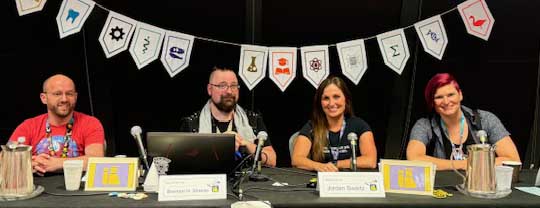
It must be another “Science is Gross” panel. Starting Friday night at 10PM, when Dragon Con is officially allowed to present mature audience content, the Science Track held “Science is Gross: The Grossening (Pt. 2)” in Hilton Room 209-211. Matthew Jarrett served as the panel moderator, with panelists Brandon H. Strauss, Jordan Swartz, and Kali Holder.
Jordan Swartz, who works crime scenes in LA County, presented Burned Remains: Investigating Fire Scenes with Human Remains. The presentation began with some basic details about what happens to bodies in a fire. She noted that most people who die in fires actually die from heat or suffocation, not from the fire itself.
Swartz then talked about how perpetrators use fire to destroy a body, prevent a victim from being identified, or to destroy evidence related to the circumstances of death. She also lamented first responders accidentally destroying evidence at the scene.
In her presentation, Swarz had lots of photos, and started with the Palisades wildfire. Some of the photos included remains from people unable to escape the fire. She showed viewers how to tell the difference between actual fire damage in a home or to a body, versus just smoke or heat damage. For instance, when a body burns in a fire, the soft tissue contracts; skin tears; fat, muscle, and organs shrink; and the cranium fractures. The extent depends on how long the body is exposed to the fire and the order.
Swarz then moved to showing multiple fire incidents with bodies, where investigators found evidence of foul play. As Swarz walked the audience through photos of the house, and zoomed in on specific points, such as a melted light switch, she also showed the discovery of a gun, which led to an extra ten hours in her search of the house. They found a body, with damage to the face that turned out to be a bullet wound. Someone had tried to cover up a murder with a fire.
After Swarz’s presentation, Kali Holder, a zoological pathologist, gave a presentation she referred to as an exploding beaver. She walked the audience through a presentation of a dead beaver from a zoo. The beaver had a bloated abdomen. Holder showed her dissection of the beaver, which included images of a bloated, and then ruptured, stomach. Along the way, she identified normal elements in a body, such as fibrin to make blood clot, serosa which keeps organs slick so they don’t stick together, and ingesta, stuff that has been eaten.
Holder then focused on the muscle tear in the stomach and her search to discover what caused it. She found signs of two different bacteria: tetrads and bacilli. One kills off tissue while the other produces gas, which led to bloating and ultimately the rupture. In response to a question concerning what led to the presence of the bacteria, Holder noted that both bacteria are naturally found in the GI tract. In this case, they got way out of balance.
Brandon Strauss wrapped up the panel with a presentation on screwworms and pigs. He started off the presentation discussing primary screwworms and the United States efforts to eliminate the fly from the country back in the 1960s. He then showed the remains of a hiker found in Argentina, and how discovery of both primary and secondary screwworm infections on the body allowed them to put together a timeline of what happened to her.
Strauss presented studies on pig decomposition and the difference between indoor and outdoor decomposition. That led to development of a Porcine ORifice Crevice Device (PORCD). PORCD is a pork belly in a tube-like device placed in a cage with flies and pollen to see if/how flies deposited the pollen on the remains.
The study helped show that experts can use pollen and spores deposited by flies on a body to determine if the body died at the location it was found or was moved. Flies only travel within a certain small area. Finding pollen from outside that area means the body was moved.
The whole panel was graphic, filled with dark humor that led to lots of laughter, and lots of audience engagement. With luck, the panelists will return next year for a Science is Gross part 3.
